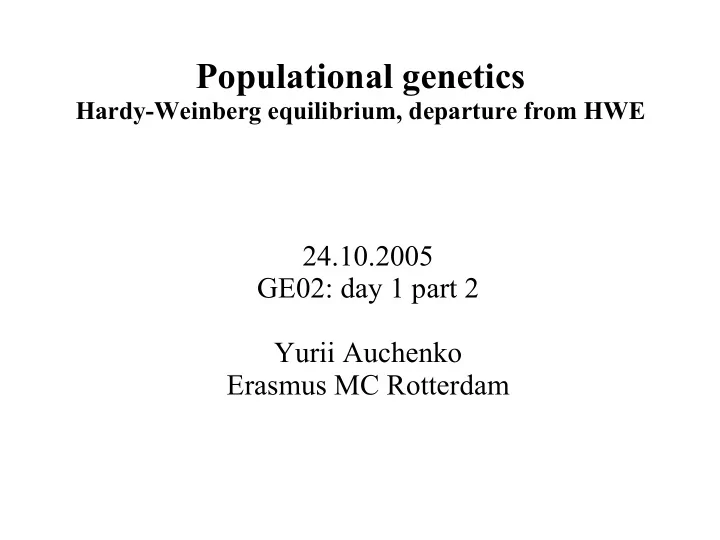

Populational genetics Hardy-Weinberg equilibrium, departure from HWE 24.10.2005 GE02: day 1 part 2 Yurii Auchenko Erasmus MC Rotterdam
What is a “population”? ● Two individuals A and B belog to the same genetic population if – the probability that they would have an offspring in commomn is greater then zero and – this probability is much higher than the probability of A and B having an offspring in common with some individual C, which is said to be belonging to other population
Genetic processes in populations ● Selection is a process of differential reproduction ● Mutation is the process in which one allele is changed to other ● Random processes, e.g. drift
Genetic processes in large populaions ● Assumptions: – infinitely large population – Generation -> Gametic pool -> Generation abstract – Random, independent segregation and aggregation of alleles
Hardy-Weinberg equilibrium ● Consider two alleles, N and D, are segregating in a population. Frequency of D, P(D) = 0.1 ● If aggregation of alleles is independent and random, what are the expected genotypic proportions?
Solution ● Homozygotes – P(N and N) = P(N) x P(N) = 0.9 x 0.9 = 0.81 – P(D and D) = P(D) x P(D) = 0.1 x 0.1 = 0.01 ● Heterozygote – P(N and D) = P(N) x P(D) = 0.9 x 0.1 = 0.09 – P(D and N) = P(D) x P(N) = 0.1 x 0.9 = 0.09 – Total, P(ND or DN) = 0.18
Hardy-Weinberg equilibrium ● If frequency of allele D is q and the frequency of N is p = (1 – q) then – P(DD) = q 2 – P(ND) = 2 p q – P(DD) = p 2 ● These proportions are known as HWE ● P(ND) is known as heterozygosity, a measure of marker polymorphism
Task ● Consider three alleles, A 1 , A 2 and A 3 , segregating in a population – P(A 1 ) = 0.1 and P(A 2 ) = 0.2 ● Aggregation of alleles is independent and random ● What is – Frequency of A 3 ? – How many genotypes can be observed? – What are equilibrium proportions?
Solution ● Frequency of A 3 ? P(A 3 ) = 1 – P(A 1 ) – P(A 2 ) = 0.7 ● How many genotypes can be observed? Six: A 1 A 1 , A 1 A 2 , A 1 A 3 , A 2 A 2 , A 2 A 3 , and A 3 A 3 ● Generally: if there are n alleles, there could be – n (n+1) / 2 genotypes
Solution ● What are equilibrium proportions? – P(A 1 A 1 ) = P(A 1 ) P(A 1 ) = 0.01 – P(A 1 A 2 ) = 2 P(A 1 ) P(A 2 ) = 0.04 – P(A 1 A 3 ) = 2 P(A 1 ) P(A 3 ) = 0.14 – P(A 2 A 2 ) = P(A 2 ) P( A 2 ) = 0.04 – P(A 2 A 3 ) = 2 P(A 2 ) P(A 3 ) = 0.28 – P(A 3 A 3 ) = P(A 3 ) P(A 3 ) = 0.49
HWE for multiple alleles ● P(A i A i ) = P(A i ) 2 ● P(A i A j ) = 2 P(A i ) P(A j ) ● Heterozygosity is defined as Σ i > j 2 P(A i ) P(A j )
When HWE is reached? ● If the frequency of genotypes are – P(DD) = 0.1, P(ND) = 0.2 and P(NN) = 0.7 ● Then – What is the frequency of D, P(D)? – What genotypic frequencies are expected under HWE? – What will be genotypic frequencies after a generation of random mating?
Follow the model… ● What is the frequency of D, P(D)? – P(D) = P(DD) + P(ND)/2 = 0.1 + 0.2/2 = 0.2 ● Now the gametes start randomly aggregate and we get HWE in one generation: – P(DD) = 0.04, P(ND) = 0.32, P(NN) = 0.64
Conclusion ● If genotypes are not in HWE, it is reached in one generation of random mating and segregation/aggregation! ● Normally these assumptions holds
Why HWE may be violated? ● Genotyping or calling error ● Sample is not from the same population ● Non-random mating ● Selection
Genotyping or calling error ● SNPs – Heterozygotes more difficult to call than homozygotes ● Microsatellites – Call errors – Missed alleles
Problem ● Three alleles (A 1 , A 2 and A 3 ) are present in a population with frequencies 0.05, 0.15 and 0.8 ● Allele A 2 is not called ● What will be genotypic distribution for such locus? ● What is the one expected under HWE?
Answer ● What will be genotypic distribution for such locus? – Genotype 11 12 13 22 23 33 – True distr. (%) 0.25 1.5 8 2.25 24 64 – Calling 11 11 13 miss 33 33 – Obs. genot. 11 13 33 – Observed% 1.75 8 88 / (1 – 0.0225) 1.8 8.2 90
Compare with HWE 11 13 33 – Observed% 1.8 8.2 90 ● What is the one expected under HWE? – P(1) = 1.8 + 8.2/2 = 5.9% 11 13 33 – Expected% 0.3 11 89 ● Excess of homozygotes!
Why HWE may be violated? ● Genotyping or calling error ● Sample is not from the same population ● Non-random mating ● Selection
HWE violation because of incorrect sampling ● Bad sample: – 50% are from population where allele frequency is 0.2 (say, European) and – other 50% are from population where frequency is 0.9 (Say, Japanese) ● Both populations are in HWE
Resulting population AA Aa aa Pop1 0.64 0.32 0.04 Pop2 0.01 0.18 0.81 Mixture 0.325 0.25 0.425 ● In mixed population, P(a) = 0.425 + 0.25/2 = 0.55 ● Expected under HWE: Expec 0.20 0.50 0.30 ● Mixture usually leads to heterozygote deficiency!
Recommend
More recommend